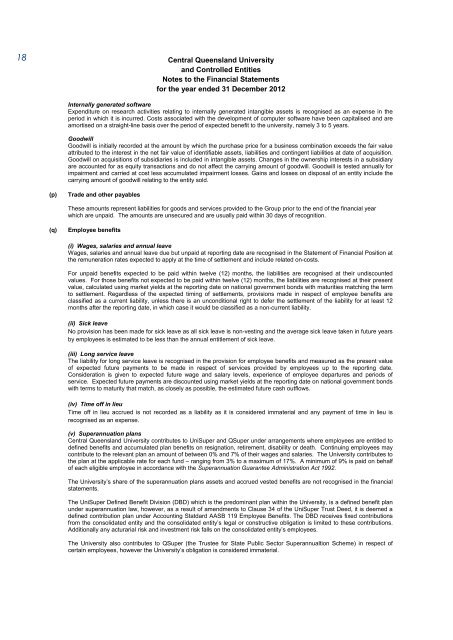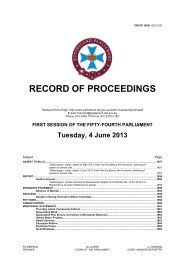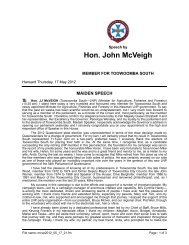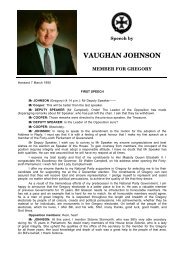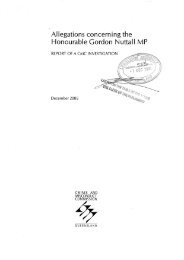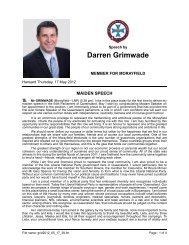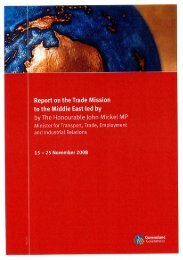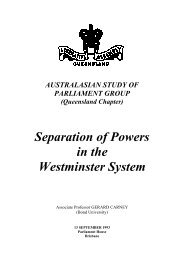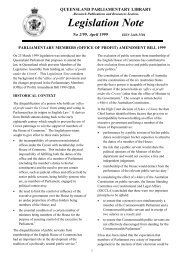CQUniversity Annual Report - Central Queensland University
CQUniversity Annual Report - Central Queensland University
CQUniversity Annual Report - Central Queensland University
Create successful ePaper yourself
Turn your PDF publications into a flip-book with our unique Google optimized e-Paper software.
18<br />
<strong>Central</strong> <strong>Queensland</strong> <strong>University</strong><br />
and Controlled Entities<br />
Notes to the Financial Statements<br />
for the year ended 31 December 2012<br />
Internally generated software<br />
Expenditure on research activities relating to internally generated intangible assets is recognised as an expense in the<br />
period in which it is incurred. Costs associated with the development of computer software have been capitalised and are<br />
amortised on a straight-line basis over the period of expected benefit to the university, namely 3 to 5 years.<br />
Goodwill<br />
Goodwill is initially recorded at the amount by which the purchase price for a business combination exceeds the fair value<br />
attributed to the interest in the net fair value of identifiable assets, liabilities and contingent liabilities at date of acquisition.<br />
Goodwill on acquisitions of subsidiaries is included in intangible assets. Changes in the ownership interests in a subsidiary<br />
are accounted for as equity transactions and do not affect the carrying amount of goodwill. Goodwill is tested annually for<br />
impairment and carried at cost less accumulated impairment losses. Gains and losses on disposal of an entity include the<br />
carrying amount of goodwill relating to the entity sold.<br />
(p)<br />
Trade and other payables<br />
These amounts represent liabilities for goods and services provided to the Group prior to the end of the financial year<br />
which are unpaid. The amounts are unsecured and are usually paid within 30 days of recognition.<br />
(q)<br />
Employee benefits<br />
(i) Wages, salaries and annual leave<br />
Wages, salaries and annual leave due but unpaid at reporting date are recognised in the Statement of Financial Position at<br />
the remuneration rates expected to apply at the time of settlement and include related on-costs.<br />
For unpaid benefits expected to be paid within twelve (12) months, the liabilities are recognised at their undiscounted<br />
values. For those benefits not expected to be paid within twelve (12) months, the liabilities are recognised at their present<br />
value, calculated using market yields at the reporting date on national government bonds with maturities matching the term<br />
to settlement. Regardless of the expected timing of settlements, provisions made in respect of employee benefits are<br />
classified as a current liability, unless there is an unconditional right to defer the settlement of the liability for at least 12<br />
months after the reporting date, in which case it would be classified as a non-current liability.<br />
(ii) Sick leave<br />
No provision has been made for sick leave as all sick leave is non-vesting and the average sick leave taken in future years<br />
by employees is estimated to be less than the annual entitlement of sick leave.<br />
(iii) Long service leave<br />
The liability for long service leave is recognised in the provision for employee benefits and measured as the present value<br />
of expected future payments to be made in respect of services provided by employees up to the reporting date.<br />
Consideration is given to expected future wage and salary levels, experience of employee departures and periods of<br />
service. Expected future payments are discounted using market yields at the reporting date on national government bonds<br />
with terms to maturity that match, as closely as possible, the estimated future cash outflows.<br />
(iv) Time off in lieu<br />
Time off in lieu accrued is not recorded as a liability as it is considered immaterial and any payment of time in lieu is<br />
recognised as an expense.<br />
(v) Superannuation plans<br />
<strong>Central</strong> <strong>Queensland</strong> <strong>University</strong> contributes to UniSuper and QSuper under arrangements where employees are entitled to<br />
defined benefits and accumulated plan benefits on resignation, retirement, disability or death. Continuing employees may<br />
contribute to the relevant plan an amount of between 0% and 7% of their wages and salaries. The <strong>University</strong> contributes to<br />
the plan at the applicable rate for each fund – ranging from 3% to a maximum of 17%. A minimum of 9% is paid on behalf<br />
of each eligible employee in accordance with the Superannuation Guarantee Administration Act 1992.<br />
The <strong>University</strong>’s share of the superannuation plans assets and accrued vested benefits are not recognised in the financial<br />
statements.<br />
The UniSuper Defined Benefit Division (DBD) which is the predominant plan within the <strong>University</strong>, is a defined benefit plan<br />
under superannuation law, however, as a result of amendments to Clause 34 of the UniSuper Trust Deed, it is deemed a<br />
defined contribution plan under Accounting Statdard AASB 119 Employee Benefits. The DBD receives fixed contributions<br />
from the consolidated entity and the consolidated entity’s legal or constructive obligation is limited to these contributions.<br />
Additionally any acturarial risk and investment risk falls on the consolidated entity’s employees.<br />
The <strong>University</strong> also contributes to QSuper (the Trustee for State Public Sector Superannualtion Scheme) in respect of<br />
certain employees, however the <strong>University</strong>’s obligation is considered immaterial.


